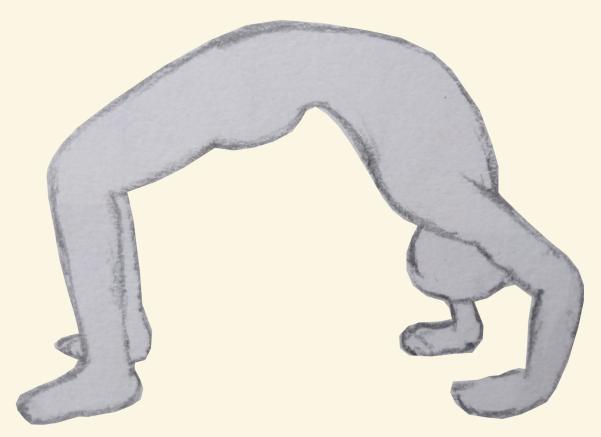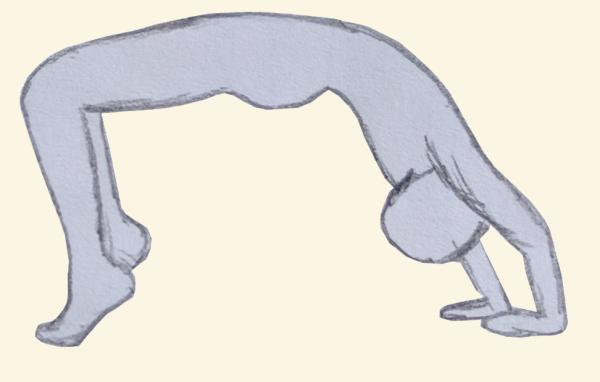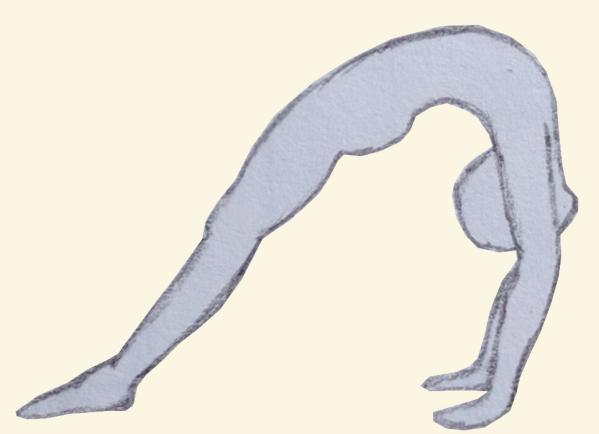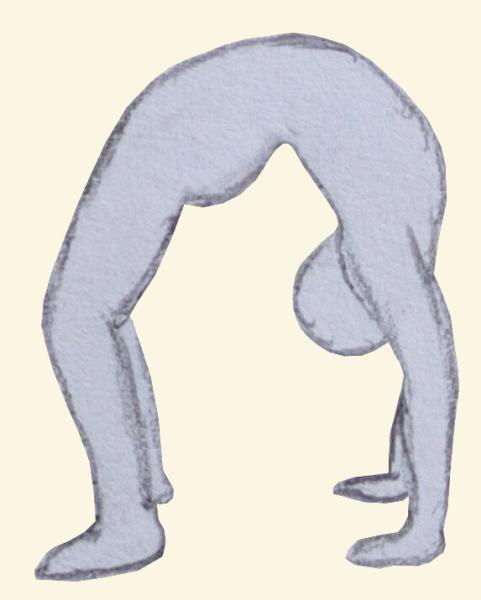Urdhva – upward, dhanur – bow, asana – pose; The upwards bow pose is known by many names like the chakrasana (wheel pose) or the bridge (in gymnastics).
We consider this pose to be one of the most important postures because it can reveal a lot of blockages in your body. From our teaching experiences, we have been able to gain some useful insights which we are going to share.
We will first explain important elements of this pose and then explain (with photos) how this pose will look if certain areas of your body are blocked like the shoulders, hips, etc. We recommend getting someone to take a photo when you try this pose and compare it with the images below to see what you think you need to work on.
Why is Dhanurasana a very important pose?
Because this posture requires openness and engagement in the whole body to reach the final pose, it can actually be a useful asana to find out where your body is blocked and what you need to work on.
The elements that need to be worked on to allow this posture to become easy are:
- Strength in the legs, arms, and shoulders
- Flexibility in the hip flexors, shoulders, chest, abdomen, and spine
- Powerful breathing muscles that allow you to breathe deeply in a restricted position
Some people find that they are able to get into something like the pose relatively easily just using their flexibility, but these people often feel that the lower back is being compressed and becomes painful over time. This happens when there is not enough strength to support the flexibility, so the way of practicing will need to be modified a bit.
What does your Upwards bow pose look like?
Depending on your body proportions, your tightness, your strength, and your flexibility this posture will look different. Here are some examples of how the posture will look different, and what you can do to fix each major issue.
Shoulder blockage

If your dhanurasana looks something like this and you are not able to straighten the arms in the pose then probably your shoulders and the upper back is blocked. Use this sequence of posture to open your upper back and shoulders.
Tight hip flexors

If your pose looks like this, and you have a tendency to lift your heel up then this tells the hip flexors are tight. You need to work on your hip flexors. Notice the bend in the wrist, this might cause an achy wrist. As a modification, you can practice this pose on blocks so that your wrist doesn’t bend so much.
To work on your hip flexors you can try the following poses, ustrasana, ashwa sanchalan asana, ardha chandrasana, etc
Your Dhanurasana might not exactly look like the above photos because it would depend on the level of your blockage. Also, the blockage could be a combination of the shoulder, upper back, and hips. Here we are attempting to bring clarity that how you can assess the postures and use it to work on areas where you are blocked.
Modify Dhanurasana to target different areas
If you have relatively flexible hips and shoulders you can do your urdhva dhanurasana to target different areas in the body.
Target upper back, shoulders, and chest

Lift up into urdhva dhanurasana, and walk your hands a little away from the feet. Press the feet and straighten your legs pushing your chest away from your toes.
To understand the action you can first try using a wall, start with lying on your back with the head touching a wall place your hands by your shoulders, and lift up. Straighten your legs and try to touch the chest to the wall.
Target the middle back

Distance between the hand and the feet is a bit lesser than the upper back variation. The main aim here is to spread the curve by engaging your muscles and not letting all the force come to the lower back. To really target the middle back actively engage your hands and imagine you are pushing the floor away from you, engage your thighs firmly press the feet and send the sternum upwards.
Target the lower back

Specifically targeting the lower back is mostly useful for people who want to go towards very deep back bending poses. Usually, this area is the most flexible but the skill is in creating enough space without scrunching. You need to learn to breathe here and you must have a strong spine and legs to support this movement. If you are doing this version you have to be extra careful not to scrunch your lower back, you have to do it in a way where the energy transfers equally in all parts of the body
For those with a naturally flexible back, you might be able to do this pose without much training, but for those people, the key will be to build the strength to support this flexibility. For many others this is a big obstacle pose that requires them to work hard in many different areas
If you are including Urdhwa dhanurasana in your practice then you can follow the below-mentioned steps and vinyasa.
Steps:

- Lie down on your back, inhale and bend your knees so that your feet are flat on the floor with the heels as close to the buttocks as possible.
- Lifts your arms up, and bend your elbows so that the hands come to the floor on either side of the head, fingers facing towards the shoulders.
- Exhale completely,
- Inhale, press the balls of your feet into the floor, and lift the buttocks off the floor. Push the ground with your hands and lift so that the crown of your head comes to the ground between them
- Keep your thighs and inner feet parallel.
- Take a deep breath.
- Inhale and straighten the arms, squeeze the buttocks and push the hips towards the ceiling. Work on straightening the legs.
- Take 5 deep breaths
- Exhale, bend your arms, and slowly lower yourself down.
- Repeat the posture
- To finish you should counteract the backward bend with a forward bend like Pachimottanasana (Intense west stretch).
Benefits:
- Stretches the chest and lungs
- Strengthens the arms and wrists, legs, buttocks, lungs, and spine
- Stimulates the thyroid and pituitary glands, helping to regulate hormones and metabolism.
- Energises a fatigued body/mind
- Good for respiratory problems such as asthma
- Reduces back pain
- Can increase fertility,
- Improve bone strength to help prevent osteoporosis
Contraindications:
- Back injury
- Carpal tunnel syndrome
- Diarrhea
- Headache
- Heart problems
- High or low blood pressure
Looking for more postures? Check our Yoga asana library.